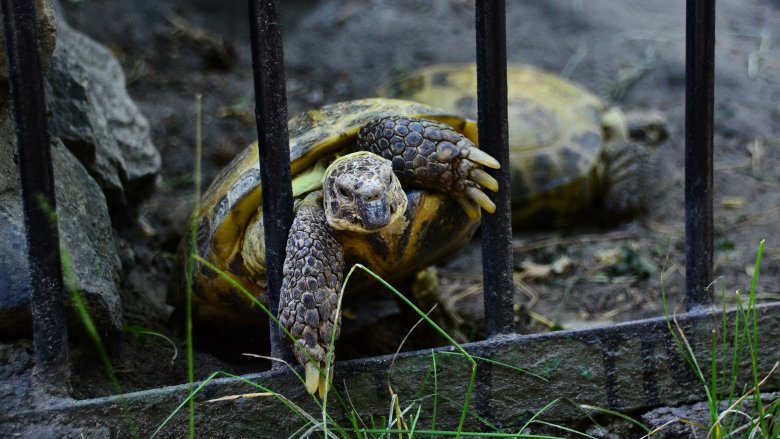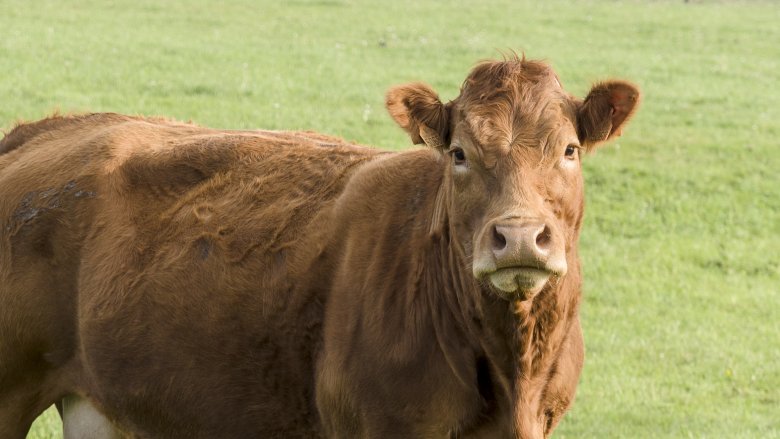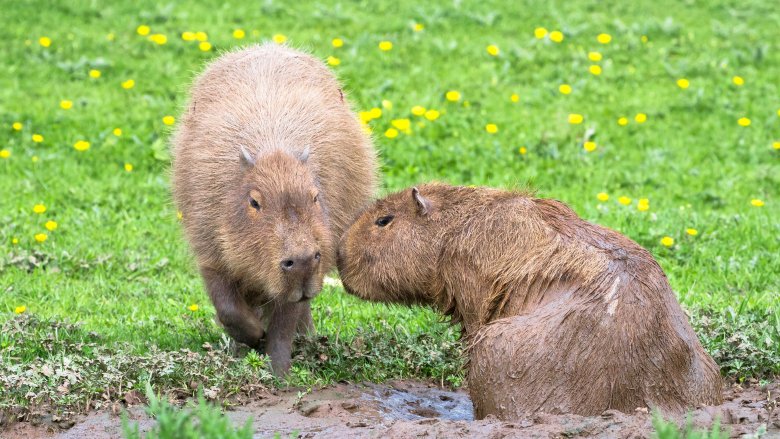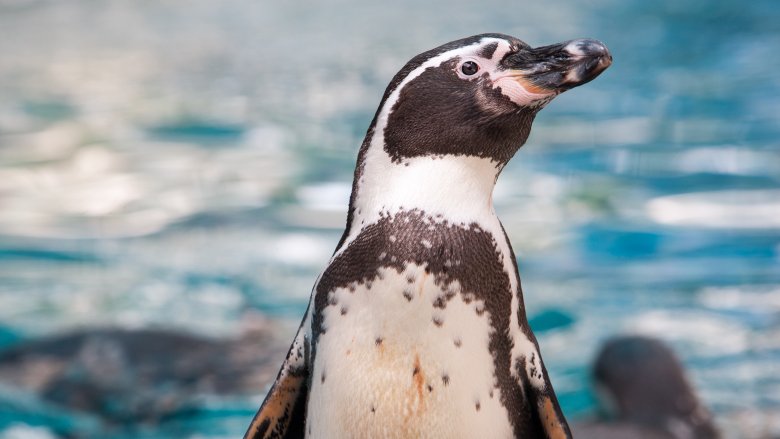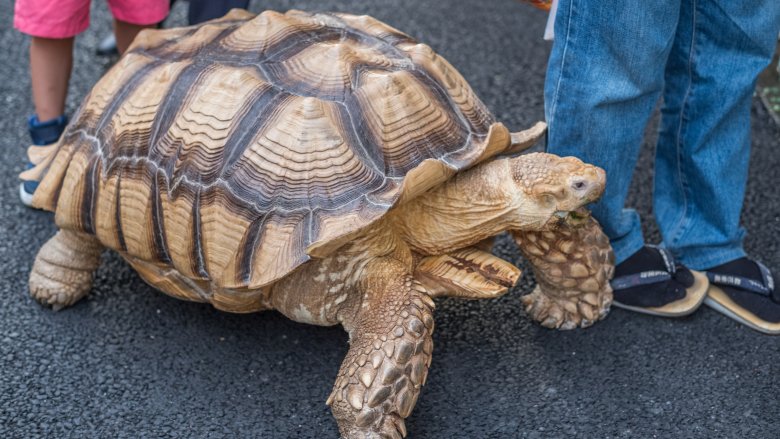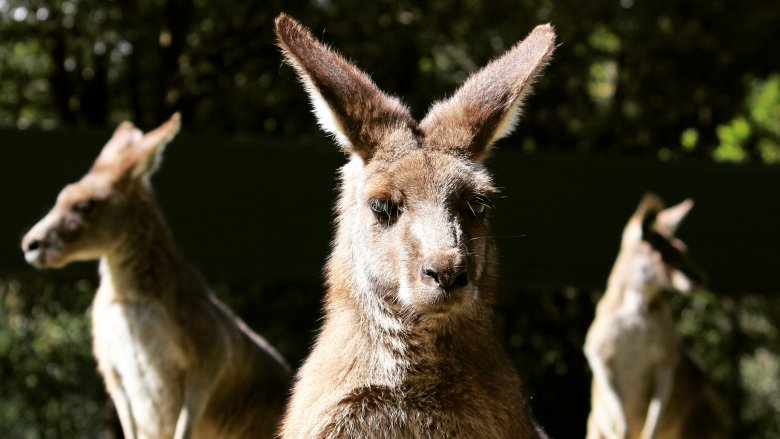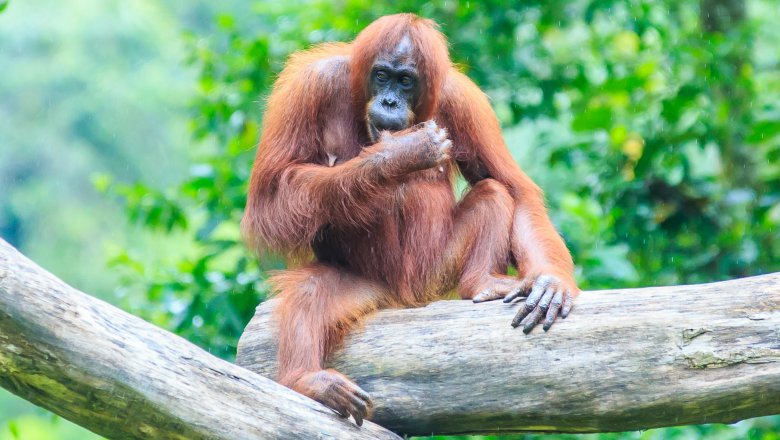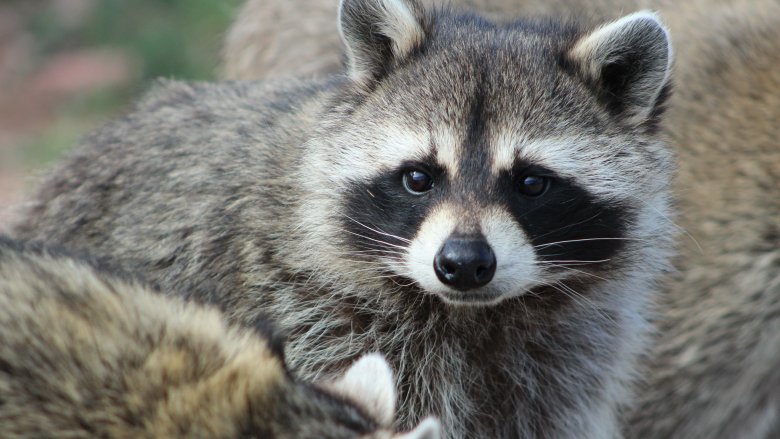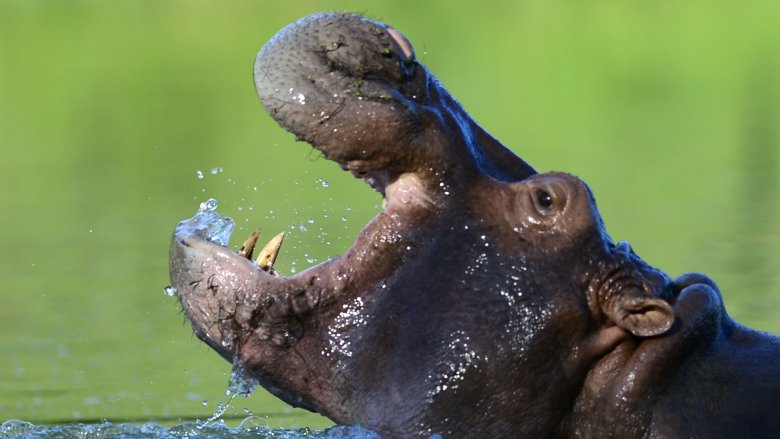The Craziest Animal Escape Stories
Ever since humans first crossed paths with animals, we've figured out ways to imprison them, eat them, put them to work, and just encourage unwavering servitude in some form or another. Often it's a benevolent and mutually beneficial relationship — dogs really do like us — but for the most part we've had no issue letting them know who the head honcho is on this planet, and said honcho has opposable thumbs, posts pictures of food online, and wears far too much product in their hair.
And time and time again, our furry, scaly, cuddly, scary, miniscule or enormous companions have proven that they're not really cool with captivity and confinement. Sometimes it's probably just a longing for freedom that drives these animal escapes, sometimes those survival instincts kick in when they're most needed, and sometimes they probably just like messing with us.
All these freebirds craved a taste of the good life, and they weren't about to let humans get in the way. And even if the majority were recaptured eventually, they've all got a hell of a story to tell the grandkids. Here are the craziest animal escape stories.
No more Mrs. Nice Cow
Well, it's happening. The bovine uprising is here, and Eastern Europe is basecamp. Either Polish cattle have started passing around a copy of Animal Farm in secret, or they've seen one too many of their bovine buds end up on a plate. Whatever it is, they're on to something, and it's kind of impossible not to root for them.
As reported by The Independent, an unnamed cow was being taken to a slaughterhouse in early 2018 when she refused to get into a transport truck, broke free, rammed through a metal fence, broke the arm of one of the farmers trying to restrain her, and made a heroic break for nearby Lake Nysa. She swam all the way to one of the lake's uninhabited islands, and has thus far evaded any attempts at recapture. As of this writing, she's still there, presiding over her well-earned kingdom of one. And this was only a few months after a kindred cow spirit in East Poland escaped her farm to go live with a herd of bison in a forest on the Belarusian border.
No news of a full-on separatist livestock revolution just yet, but this would be a compelling way to start one. And you can't say we don't have it coming. Maybe empty your freezer of beef products and start learning to speak bovine now just in case.
Lovers on the lam
Dubbed Bonnie and Clyde at the time of their escape, two juvenile capybaras became local celebrities in early 2017 after they both made a break for it during a transfer to High Park Zoo in Toronto. They didn't rob banks, but they stole the hearts of a nation.
The escape story made headlines the world over, and locals started using the hashtag #CapybaraWatch to tweet updates and report sightings. The public's enthusiasm turned out to be counterproductive, however, as the capybaras frequently became spooked with so many people around hoping to catch a glimpse. Even so, they were both ultimately trapped and returned safely after over a month on the lam. The second was captured two weeks after the first, so she enjoyed a slightly longer spell of freedom than her beau. Or vice versa — they were both too young at the time to determine their gender, so the question of which one was Faye Dunaway and which was Warren Beatty was anyone's guess.
"They're young, they're in love, and they kill people" was Bonnie and Clyde's tagline back in 1967. These two furry fugitives were also young, also in love (just play along, you grinch), and they mostly just ate grass and took naps in the mud. But it was the happy ending that really distinguished their story from that of their gun-toting namesakes. They seemed to take a liking to domestic life, and had three mini-capybaras together a year later. Those kiddie capybaras have a lot to live up to.
Humboldt penguin's escape goes swimmingly
Gandalf the Grey once said "Even the smallest person can change the course of the future," and who are you to argue with Gandalf? This humble Humboldt penguin — affectionately known as "Penguin 337" — didn't really have aspirations that lofty or a great ring of power to destroy, but it did become one of the most famous creatures in Japan and beyond after escaping from Tokyo Sea Life Park in early 2012, as reported by The Guardian. And if it had had a little more time to find its feet, who knows how far it could've gone?
It was an impressive bid for freedom. The scrappy little so-and-so scaled a 12-foot rock wall before squeezing through a barbed wire fence to the outside world, sweet liberty within its reach, and the world was on its side. Everyone was talking about 337, and the locals wanted a closer look. The aquarium received 30 confirmed sightings of the penguin, mostly enjoying a leisurely swim in Tokyo Bay, seemingly in no hurry to get anywhere in particular but still managing to elude capture by the Japanese coast guard at one point. It was finally captured more than 5 miles away from the park, 82 days after its escape. Not a bad run.
Abuh absconds
Keep an eye on the quiet ones, especially if they reside in Japan's Shibukawa Zoological Park. As reported by Time, Abuh the giant tortoise made a name for herself there in August 2017, when zoo officials found she'd gone missing and had to ask locals to keep an eye out for any hard-shelled 120-pound escape artists strolling around where they shouldn't be.
This 35-year-old troublemaker — a lithe young whippersnapper in tortoise years — had been allowed to roam freely around the zoo, which turned out to be a shortsighted underestimation of her ability to pull off a stealthy getaway. This was Abuh's second escape in the span of a month, too, so it really took them a while to cop to her remarkably independent spirit. The jig was up when she was discovered two weeks later, and it seems she didn't make much of her time on the lam. She wasn't chilling in Aruba with mai tais and sand castles, but instead just hiding in some shrubbery about 500 feet from the zoo. As they say, life isn't about the destination for some so much as the really, really slow journey.
Unlikely friends in unlikely places
"Individual commitment to a group effort — that is what makes a team work, a company work, a society work, a civilization work," according to legendary NFL coach Vince Lombardi. He could have probably extended this to include zoo escapes. This particular group of animal escape artists — a fox, a wild boar, and three kangaroos — didn't exactly get together in a smoky warehouse over a set of blueprints to hash things out, and their effort wasn't entirely successful, but still. With a bit more communication and careful coordination, this team could really go places.
In August 2012, as reported by CBS News, the three kangaroos in question escaped from their enclosure in a German zoo through a hole that the intruding fox had dug near the cage's fencing. This was as far as it went for one of the roos, but the other two went on to escape the zoo entirely through a hole the boar had dug through the exterior fence. Presumably they all then went their separate ways wearing fake moustaches and baseball caps. The roos were recaptured soon enough, but here's hoping the five of them managed to plot their next job in the brief time they had together.
Living for llama drama
Even the most seemingly sedate and content animals get that palpable yearning for freedom, and once they get a taste, there's no stopping them until that thirst has been at least partially quenched. In February 2015, two unassuming llamas were being taken to a retirement community in Arizona for a show-and-tell presentation when that rebellious mood struck them. Obviously not content with entertaining old folks for the afternoon, these two mavericks flew the coop and decided to give the rest of the world a show, as reported by the BBC.
As the llamas weaved through traffic and evaded their pursuers with measured grace and poise, a local television station filmed the action in real time from a helicopter. It wasn't exactly the white Bronco chase, but it didn't matter. People laughed, people cheered, and people tweeted. #llamawatch and #teamllama were trending, and the story's popularity reached its peak with more than 3,000 tweets per minute at one point. Eventually they were captured and everyone went about their day, but for a while there, Llama Drama was all that mattered. Watch the thrillingly high-speed pursuit above.
The San Diego Zoo's Hairy Houdini
Ken Allen the orangutan developed a knack for escaping very early on in life, and was basically an old pro by the time he got to the San Diego Zoo in the '80s. This guy was on another level, racking up a total of four successful escapes between 1985 and 1987, and becoming a beloved local celebrity in the process.
His first escape saw him scaling a wall and strolling down the zoo's public path, all "hello, compatriots," as if he were just another visitor. Zoo officials increased security in his pen, but he escaped a few weeks later. Not long after that, his third breakout saw him tossing a crowbar to another orangutan, Vicki, who used it to pry a window open and let him out. Things were getting a little too Planet of the Apes for the zoo staff by this point, so added even more security. But two years later, his fourth and final successful escape saw him walking across the dry moat outside his enclosure after the water pump clogged. Ken probably would've been running the zoo himself soon enough, but sadly he died of cancer in 2000.
Nicknamed "Hairy Houdini," Ken became something of a folk hero at the time. Some people claimed to have posed for pictures with him during one of his escapes, T-shirts and bumper stickers were sold, and a fan club was started. This was the '80s, and tacky materialism was the name of the game. But if anyone actually deserved all this fanfare, it was Ken.
Baboons make a break for it
Baboons aren't technically apes, but these four free-spirited sons of guns definitely seemed to be following in the hallowed footsteps of Ken Allen in April 2018, when they booked it from a biomedical research lab in San Antonio.
According to CNN, the gang upended a 55-gallon barrel that had been placed in their enclosure for enrichment and recreation. There's only so much a big blue barrel can actually provide in the way of diversion, and obviously this one served a much better use as an animal escape aid. They used it to climb out of their circular open-air structure and make a break for it. One of them chickened out and returned before breaching the perimeter, but the other three went for broke. One even managed to make it all the way to a nearby street, with the animal capture team in hot pursuit. They were all successfully and safely recaptured within half an hour, and that blasted blue barrel was removed.
Little rascals
Some animal escape stories are memorable not for the lovable rogues at their core, or the manner of their escape, or even the potential for plush toys and straight-to-video family romps. No, some animal escape stories are notable for the bizarre sociocultural circumstances and ecological damage they caused — damage that continues to resonate decades later.
Remember the hit 1977 anime Rascal the Raccoon? Probably not. But if you happened to grow up in Japan around that time — and if making poor decisions was a hobby of yours — not only did you probably watch the show, you might have even liked the titular raccoon character so much that you decided to have a real raccoon imported as a pet. After all, everyone else was doing it.
Years after the show aired, at least 1,500 raccoons were being shipped into Japan every month, according to Atlas Obscura. In a not-at-all-surprising turn of events, these very blatantly wild animals ended up escaping — or were simply let go — and started wreaking havoc on their surroundings. Today, they destroy crops and cause hundreds of thousands of dollars a year in agro-destruction, steal food from vendors, cause untold damage to historic temples, and are beginning to encroach on native species.
The lesson here is either that wild animals make terrible pets, that cartoons should not inform major life decisions, or that raccoons will always go out of their way to be jerks and ruin everything. Probably all three.
Colombia's hippo hoopla
The legacy of Pablo Escobar is defined by messy contradictions and mixed feelings. In Medellín, the city his cartel called home, you're as likely to come across someone selling mugs and ashtrays with his face on them as you are to see someone spitting on his grave. But aside from the trail of dead bodies left in his wake and the entertainment-industrial complex his legend has spawned, the most persistent reminders of Escobar's memory are the big, lumbering hippos that roam the Colombian countryside.
In the early '80s, Escobar built a public zoo on his estate containing a wide variety of exotic animals he'd smuggled into the country. Among these were four hippos he procured from a California zoo, three females, and one exceptionally frisky male. When the Colombian government seized the estate in the early '90s and most of the animals were removed, the hippos were left there, and they eventually escaped through a fence and into the nearby Magdalena River.
Today, more than 50 hippos roam the Colombian countryside, all descended from the original male, according to The New Yorker. Ecologists don't really know what'll happen here but have expressed concerns over the hippos upsetting the local ecosystem or becoming a danger to humans. Colombian authorities suggested a cull to thin their numbers, but the public wasn't about to let that happen, having experienced enough violence for one lifetime. The hippos are here to stay for now.
